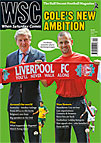 With a new season comes an array of redesigned kits. Mark Segal has spotted a strong nostalgic influence in this year's crop and wonders if we couldn't just have a little more innovation
With a new season comes an array of redesigned kits. Mark Segal has spotted a strong nostalgic influence in this year's crop and wonders if we couldn't just have a little more innovation
When the new Premier League season kicks off in the middle of August, 18 out of the 20 teams will be playing in new strips. Over the past few seasons the official kit unveiling has become as much a part of pre-season routine as money-spinning tours to far-away places and Barcelona’s pursuit of Cesc Fàbregas.
This year’s fashion parade is the usual mixture of the good, the bad and the same (what can Newcastle really do with black and white stripes?) but what is really starting to grate is that every kit has to tell a story. It’s no longer good enough for manufacturers to present a new way of displaying a team’s traditional colours – there has to be a reason for the kit they’ve chosen.
So Liverpool’s new kit “represents a modern interpretation of the one worn during the triumphant 1989-90 campaign”. That of course was the last season that the League title went to Anfield. Also harking back to previous glories are Arsenal, who are beginning to run out of successful kits to imitate. Two seasons ago their kit was a replica of the one Michael Thomas wore the night he won the Championship at Anfield, while last year’s away effort was based on the kit worn by Herbert Chapman’s all-conquering side in the 1930s. This time round it will be a throwback to Bertie Mee’s double-winning side of 1971. If they carry on like this they could be recycling designs worn less than a decade ago when Arsène Wenger’s side was actually winning trophies.
And so it goes on. Everton’s shocking pink away kit is a nod to the League-winning side of 1891, Tottenham have gone for an 1980s theme with their home shirt while West Ham’s new away kit is a replica of the one the Hammers wore in the late 1950s when Bobby Moore was just breaking into the first team. Most bizarrely Manchester United’s new home kit, according to their official website, “leans towards a classic look, inspired by the 1970s”. That will be the decade when United were relegated and won just one trophy, the FA Cup in 1977.
As far as kit designs go we are stuck in an ever-decreasing circle. It seems clubs and manufacturers are scared to produce anything slightly left-field and now just play it safe. Tell the fans that it’s part of the club’s history and they’ll accept it, no matter what far off event it is supposed to be celebrating.
The opposite argument to all this is that at a time when clubs are moving ever further away from their traditional support and becoming virtually unrecognisable from the organisations they were not that long ago, the kit is an important link to the past. The problem with this view is that after the initial summer press release which talks of the historical significance of the design and the obligatory picture of the team’s current star next to a golden moment from history, nothing more is made of the link. The kit simply becomes another way of fleecing the fan. But my call is not for clubs to never change kits again. For a start it would obviously never happen and also there’s still something childishly exciting about seeing your side run out in a new strip at the start of the season.
What I’m asking for is that clubs and kit designers start to design again. All the information we get about kits being made from recycled materials and having better sweat receptacles is all very worthy but that’s industry talk. What we want are innovations in the thing we see our teams wearing. Obviously not everyone will get it right, but even when they go horribly wrong – Coventry’s brown kit the obvious example – they become classics in themselves. I want clubs to try something new. Put some hoops here, a stripe or two there. Why has no one ever tried zig-zags before?
When I was a kid I used to love drawing the outline of a kit and then taking out my felt tips and designing my own. I’m guessing there are number of designers out there working for the big brands who probably started out in the same way and are desperate to be let off the leash. Instead they are told to delve into a club’s history, pick a kit they like – if you can link it to an anniversary even better – and then pretty much copy it. This approach may in some small way warm the hearts of fans as they hand over yet another £50, but it’s a short-term approach. If we carry on like this there will never be a modern classic.
From WSC 283 September 2010